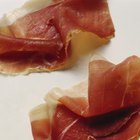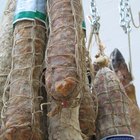
Cold cuts aren't limited to the sliced turkey and ham you may have stored in the fridge to make a quick sandwich. These basic types you buy in shrink wrap or from the deli counter at the grocery store are only a tiny selection of the vast array available, especially if you look to countries such as Italy, Germany and France. Seek out more exotic types of cold cuts to elevate your sandwiches to something truly special or to perk up a tired charcuterie tray.
Hams
Ham cold cuts show up in dozens of cultures. American ham used for cold cuts is cured either in a wet process or via smoke. American ham varieties often use sugar or honey as additional curatives. Black Forest ham, which originally hails from Germany, is an example of a wet-cured ham that is also smoked. Italian prosciutto is dry-cured, which results in an intense, salty meat that should be sliced super-thin for platters and sandwiches. The French ham known as Bayonne and the German Westphalian ham are processed in much the same way as prosciutto.
Beef
In addition to the traditional roast beef common at American deli counters, you can find corned beef and pastrami. Corned beef comes from beef brisket that is cured with salt and spices such as bay leaves, peppercorns and mustard seed and simmered in water. It tastes much like pastrami, another beef cold cut, which is seasoned and dry-cured. A cold cut less common in the United States is rauchfleisch, a specialty of Germany that consists of thinly sliced smoked beef.
Salami
Salami is an Italian specialty that can include a mix of beef and pork and is cured with spices and garlic. Genoa salami is a hard air-dried version, while cooked salamis such as cotto are softer. Another Italian salami, soppressata, consists of a fatty pork seasoned with peppercorns.
Sausages and Forcemeats
Salami is only one type of cooked or dried sausage that can adorn sandwiches or antipasto platters. Soft sausages, such as liverwurst or bologna, are American examples of forcemeat -- a combination of lean meat and fat emulsified together through grinding, sieving or pureeing. American bologna is based on mortadella, an Italian forcemeat that is smoked and flavored with garlic. Mortadella usually has small bits of fat and pistachios peppering each slice and is used in the classic muffaletta, an Italian submarine sandwich. Tongue is a staple in New York delis and can be made from beef or pork and sometimes veal or lamb. Tongue is actually processed into a sausage that consists of cooked, pressed and jellied meat from the animal's tongue; the product is sometimes smoked. Summer sausages originate in Germany and include Landjaeger and Thuringer. Americans use this spicy, relatively dry sausage sliced on meat and cheese trays or on sub sandwiches.
Poultry
The turkey and chicken breast you buy at the deli is made from multiple birds' breasts that are ground, pressed together and cooked. If the cold cut doesn't specify breast, it probably contains any number of different parts of the bird. "Cooked" means the poultry product has been treated with steam heat; honey-roasted cold cuts are coated with honey and then oven-baked; smoked cold cuts are roasted in the presence of smoke; those that say "smoke-flavored" or "artificial smoke added" mean they have been treated with either liquid or powdered smoke flavorings or chemicals that mimic the flavor of smoke. Turkey and sometimes chicken may be processed like beef and pork to create turkey pastrami, turkey ham, turkey bologna and turkey salami.
Related Articles

Different Kinds of Lunch Meat

Can I Eat Prosciutto Ham Without ...

What Is Liverwurst Made Out Of?

What Is Hog Casing Made Of?

How Long Will Dry Salami Last if Not ...

Types of Portuguese Sausage

How to Do Corned Pork

The Differences Between a Gyro & a ...
What Cut of Meat Do You Use to Make ...

List of Cuban Foods

What Is a Picnic Roast?
How Long Do You Smoke Ham Per Pound?

How is Pepperoni Made?

When Does Salami Spoil?

About Fresh Ginger Substitutes
Prosciutto Substitute

What Is a Black Forest Ham?

The Difference Between a Sirloin Roast ...

What Are the Dangers of Eating Venison?

What Type of Meat Do They Use to Make ...
References
- The Cook's Thesaurus: Cold Cuts
- The Cook's Thesaurus: Ham
- Garde Manger: The Art and Craft of the Cold Kitchen; The Culinary Institute of America
Writer Bio
Andrea Cespedes is a professionally trained chef who has focused studies in nutrition. With more than 20 years of experience in the fitness industry, she coaches cycling and running and teaches Pilates and yoga. She is an American Council on Exercise-certified personal trainer, RYT-200 and has degrees from Princeton and Columbia University.
Photo Credits
Goodshoot/Goodshoot/Getty Images